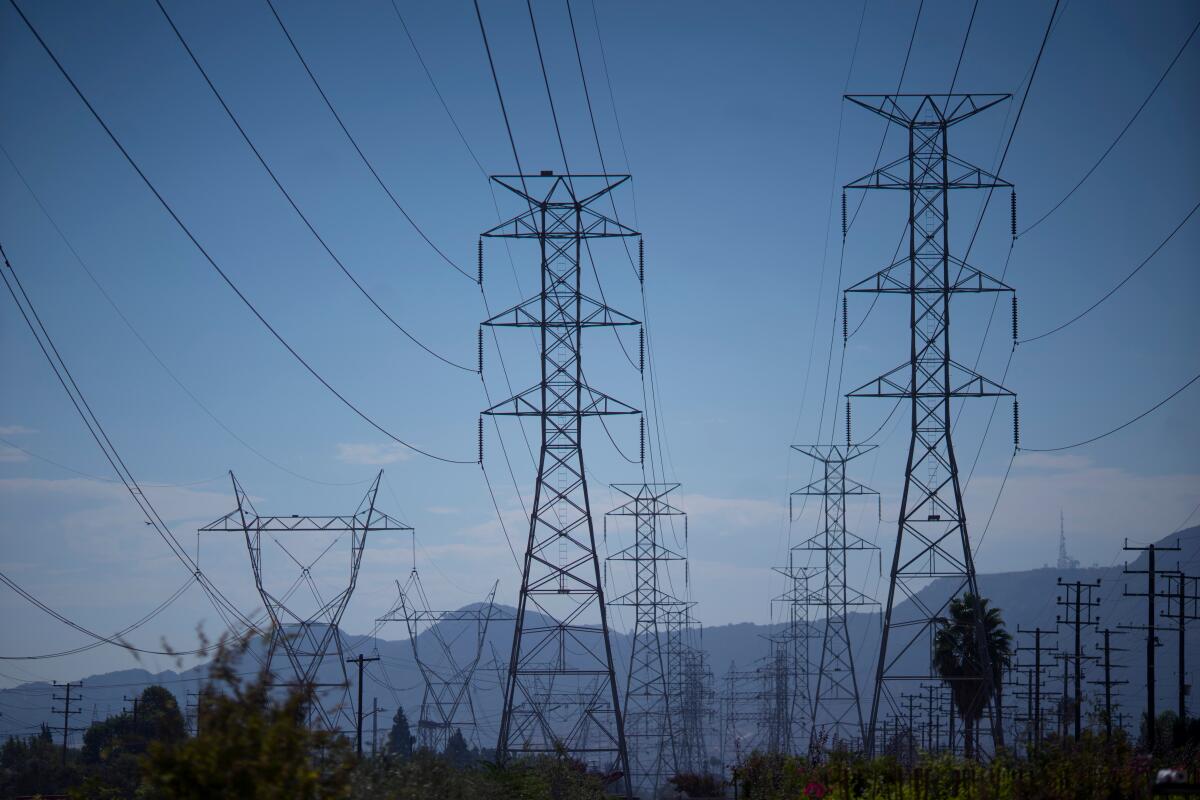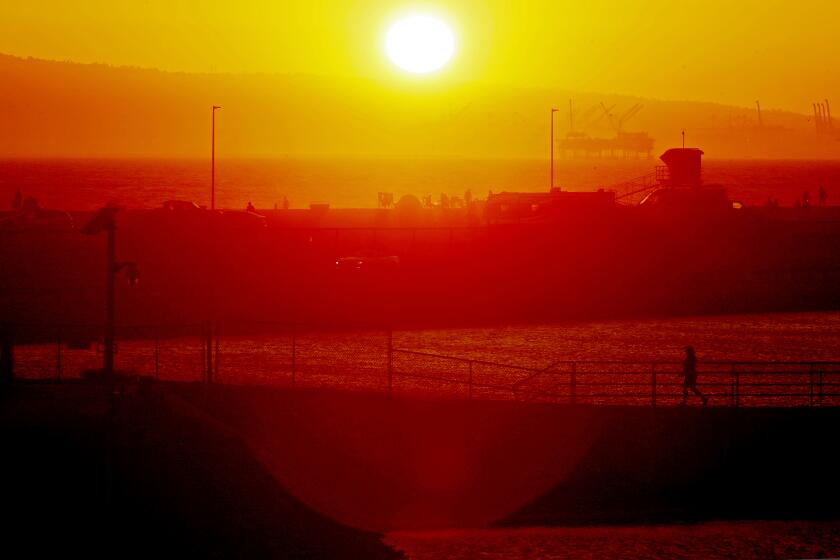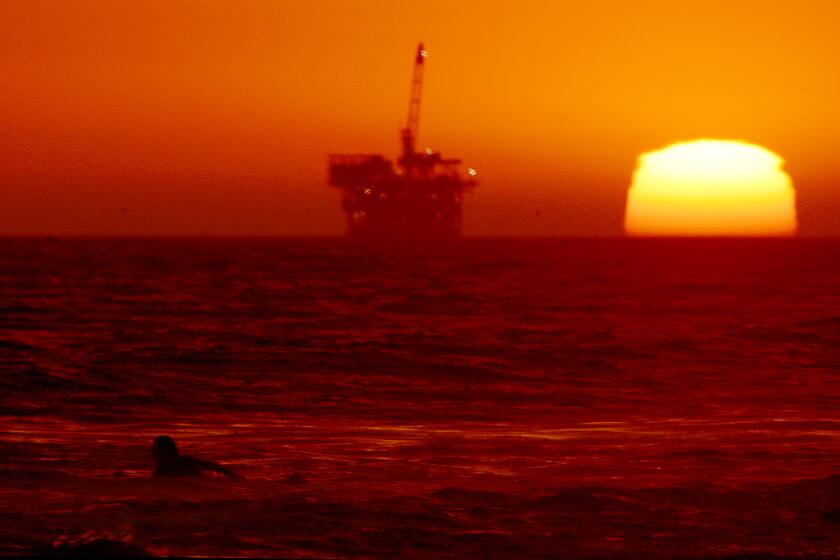A text asked millions of Californians to save energy. They paid heed, averting blackouts

- Share via
About 5:45 p.m. Tuesday, millions of Californians’ cellphones lit up with a new type of emergency alert: “Conserve energy now to protect public health and safety.”
That text message proved crucial in helping avoid rolling blackouts during one of the worst days of a grueling heat wave that has roasted the state for more than a week, taxing California’s power grid daily.
“Within moments, we saw a significant amount of load reduction showing up, to the tune of approximately 2,000 megawatts over the next 20 to 30 minutes,” said Elliot Mainzer, president and chief executive of the California Independent System Operator, which runs the state’s power grid. “That significant response from California consumers to the wireless emergency alert allowed us to restore our operating reserves and took us back from the edge of broader grid disturbance.”
Record temperatures. Hot nights. Broiling beaches. Why this California heat wave was so extreme.
The unprecedented demand and oppressive temperatures have imposed continuous stress on the state’s power grid, where capacity is already stretched due to diminished hydropower supplies because of the drought. In addition, solar energy levels off in the evening. Other neighboring regions from which California imports energy are facing the same challenges.
So despite California’s impressive conservation efforts Tuesday, the close brush with power interruptions renewed questions about how the state’s energy system will manage going forward, especially as climate change is projected to intensify extreme heat events. On Wednesday evening, officials again warned of potential outages as the heat wave dragged on and demand soared.
“The heat wave highlights really well that California is really behind in our resource build-out,” said Carrie Bentley, chief executive of Gridwell Consulting and a former California ISO policy designer, adding that the state has failed to “plan holistically” for maintaining energy reliability while confronting climate change.
About 30 minutes before the wireless emergency alert went out Tuesday, the ISO had readied local utility providers to implement rolling blackouts if conditions did not improve.
The state just reached record-setting electricity demand, and there was no sign that usage would ease.
“We were well into the reserve tank of the car,” Mainzer said. “We were down to the last gallon there.” That is, until the text alert was issued.
“Extreme heat is straining the state energy grid. Power interruptions may occur unless you take action. Turn off or reduce nonessential power if health allows, now until 9pm,” the text said.
The high-pressure system over most of California is expected to bring record-breaking temperatures, part of a “self-perpetuating” system that is becoming more extreme as climate change worsens.
The alert system has typically been used for Amber Alerts or location-specific imminent threats, like wildfires. “It is pretty unprecedented [for the emergency alert system] to be used this way, particularly for energy,” said Brian Ferguson, a spokesperson for the Governor’s Office of Emergency Services. But it was deemed necessary given the impending risk of power failures, he said.
California has been in the throes of the most brutal September heat wave in state history, with stifling hot days leading into nights that are setting record-high lows and offering little relief.
“Our absolute intent is not to have to do that again,” Mainzer said of the text message. “That is a tool of absolute last resort.”
He called Tuesday an “extraordinarily challenging day” for the power grid, almost pushed to the brink as record-setting temperatures scorched much of the state. Officials projected peak demand at 51,146 megawatts, but by Tuesday evening, California set an all-time record of 52,061 megawatts.
Tuesday’s record surpassed the previous all-time peak of 50,270 megawatts in July 2006.
There have been several close calls with blackouts in the last few years; the state’s most recent power outages occurred over two nights in August 2020. The state has continued to build up a demand-response and backup capacity, but the system remains vulnerable to the effects of climate change and extreme weather events like this historic heat wave. Officials rely on Flex Alerts, which have been issued every evening for the last eight days, to alleviate stress on the power grid.
“We do not like to have to be asking for this, but this heatwave is extraordinary,” Mainzer said.
Mark Toney, executive director of the Utility Reform Network in San Francisco, said the state’s long-term solution is to continue diversifying renewable energy. In the meantime, he doesn’t think asking Californians to pitch in and relieve pressure on the grid is concerning.
“This is the longest period in a row that we’ve had this kind of heat wave, and so it’s impressive that there have not been blackouts and brownouts up until now,” Toney said. “During critical times, I would expect [voluntary conservation] would still be needed, and I don’t think there’s anything particularly wrong with that.”
The California Independent System Operator had issued a level 3 alert, a sign that the grid couldn’t meet the state’s electrical needs.
Some local utility providers in Northern California initiated short-lived blackouts Tuesday night, citing direction from the ISO. But Mainzer insisted Wednesday morning that providers were only told to “be prepared to trigger rotating outages.” He said that there was “some level of confusion” that is now under investigation, and that those blackouts were unnecessary.
According to the California Governor’s Office of Emergency Services, which issued the text alert, residents in certain counties were targeted because of high temperatures, population density and air conditioner use. The alerts were sent to residents in Alameda, Butte, Contra Costa, El Dorado, Fresno, Kern, Kings, Los Angeles, Madera, Marin, Merced, Orange, Placer, Sacramento, San Joaquin, Santa Barbara, Santa Clara, Shasta, Sonoma, Solano, Stanislaus, Tulare, Ventura and Yolo counties.
There are about 27 million people in the targeted counties, Ferguson said. Alerts were sent in English and in Spanish.
San Francisco, Marin and Humboldt counties are among those that did not receive alerts. Although they have large populations, most people there do not use air conditioning.
Forecasters, meanwhile, say Southern California’s heat wave will ease by Friday — but more potentially dramatic weather is on the way.
Hurricane Kay is expected to bring plenty of moisture to Southern California, with temperatures still forecast to be high heading into the weekend and humid conditions sticking around through Sunday.
Kay, a system off Mexico’s Baja California peninsula, could bring humidity, flash floods, high winds and strong surf to Southern California. Mark Moede, a meteorologist at the National Weather Service in San Diego for nearly 30 years, called this week a particularly “extraordinary” weather event for the region.
“We could go from a day where we get hot, dry, maybe Santa Ana-type weather, and the following day ... there will be areas of rain,” Moede said of the shift in weather patterns from Friday to Saturday. “It is going to be a very dynamic end of the week regarding weather.”
More to Read
Sign up for Essential California
The most important California stories and recommendations in your inbox every morning.
You may occasionally receive promotional content from the Los Angeles Times.















